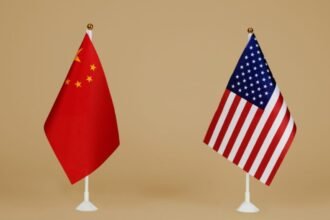Trump is causing havoc with the tariffs, and the world economy is reeling because of this. Asia is taking the sharp end of the stick as a result. With the U.S. tariffs poised to undermine international trade, companies all over the continent are busy trying to make adjustments. Business firms are doubling back on their plans to deal with increased confusion over trade policy in the United States. On the part of shifting tariffs and trade regulations, a great number of Asian countries are heavily challenged in their attempts to achieve stable economic growth. Companies in the region are forced to revise their long-term strategy because of uncertain aspects of trade.
- What are the Direct Consequences of the Tariffs imposed by Trump on Asian corporations?
- What is Tariff Uncertainty and How Are Southeast Asian Economies Managing It?
- Is There Any Chance That This Can Result in a Global Supply Chain Change?
- What will be the role of China in changing the economic order?
- Final Thoughts: Future of Asia in the World of Tariff Mystery.
What are the Direct Consequences of the Tariffs imposed by Trump on Asian corporations?
The tariff frenzy created by Trump has hit business investment hard with the Trump tariff changes leaving many on their toes. Tan Yew Kong, the man who runs operations of GlobalFoundries in Singapore compares the predicament faced by the chip manufacturer to that of a tailor who customizes a suit but now the company is taking a stab at customizing its future according to which ways of the United States policy will bend and sway.
GlobalFoundries is among the largest semiconductor production companies worldwide that cooperate with such technological giants as AMD, Qualcomm, and Broadcom. However, the company is struggling with an unknown future as the tariff turmoil unleashed by Trump has added a spanner to the global operations of the company. As tariffs jumped in the air, the company has promised to work alongside U.S. officials to relocate some of its supply chains to the U.S to mitigate the effect of the tariff tsunami. Here is the link to our article on Tariff Risk Rising
What is Tariff Uncertainty and How Are Southeast Asian Economies Managing It?
The most susceptible area is Southeast Asia, as countries such as Vietnam, Malaysia, and Singapore are in the line of fire. The tariff mess that Trump has created has already resulted in heavy taxes on major exports of Asia like electronics and textiles, which may upset their economies years down the road. Nevertheless, countries such as Vietnam have negotiated good tariff agreements that have ensured that they retain a bit of U.S. market access.
In the meantime, other countries such as Malaysia are being subjected to a 20-25 percent increase in tariffs on different exports, whereas Singapore will continue to be hit by a 10 percent tariff despite a U.S.-Singapore free trade agreement. Businesses located in vouched areas feel that there is nothing except uncertainty in the future and companies have to reconsider their long-term plans, starting with correcting the inventory of items to investigation of new markets.
What are the Further economic directive Trump’ssh With Trump tariff mayhem continuing, the economic orientation in Asia might witness some changes on a large scale. Experts reveal that such economies that are over-dependent on exports such as Vietnam and Singapore will be worst hit. On the contrary, the countries that have large domestic markets may be less vulnerable to such trade shocks as India.
This ripple effect has already been experienced in certain industries such as chip manufacturing, textiles, and automotive supply streams, where they either reassess their supply chains or are moving operations. As long as China has been one of the important links in the global chain of supply, any significant alterations in business relations can result in civilization-scale adjustments in regional partnerships and manufacturing principles.
Is There Any Chance That This Can Result in a Global Supply Chain Change?
The insecurity caused by the tariff madness of Trump is causing most businesses to evaluate their supply chain strategy. Other companies are also establishing a more diversified manufacturing platform by doing a China + 1 strategy by moving manufacturing to countries in Southeast Asia, such as Vietnam, Malaysia, and Thailand. This approach enables the companies to protect themselves against geopolitical issues, which makes them more responsible for disrupted supply chains in the event of a possible tariff increase.
Conversely, the tariff madness triumphed by Trump may place the nation on the path of regionalization as opposed to globalization. Businesses can explore other manufacturing hotspots in other states, such as the Philippines or Indonesia, where the tariffs have a lower tariff rate, thus making them trade less with China and the U.S. Here is the link to our article on Tariff War Deepens
What will be the role of China in changing the economic order?
With the tariff madness in Trump washing away, calls to China are sounding as a prospective replacement in the international trade infrastructure. According to Professor Pushan Dutt at the INSEAD school, there is an opportunity for Chinatto take the position of world trading order guardian as the U.S. descends into protectionism.
Although the U.S. is likely to continue to serve as a critical marketplace to many Asian firms, other corporations may find themselves more interested in China as a place of business and investment, and supplying chain will take a new geographic location.
Final Thoughts: Future of Asia in the World of Tariff Mystery.
With Trump’s tariff chaos ongoing, as Trump takes the world through such a crisis, companies in Asia are entering into a new world order of heightening protectionism and altering trade relationships. The capacity of this region to pass through this phase of uncertainty will be defined by the ability of companies to diversify their operations, find new markets, and harmonize themselves with the changing profile of tariffs. Ultimately, the ability to balance resiliency and flexibility in this increasingly unpredictable world will likely become the key determinant of long-term growth in Asia.








